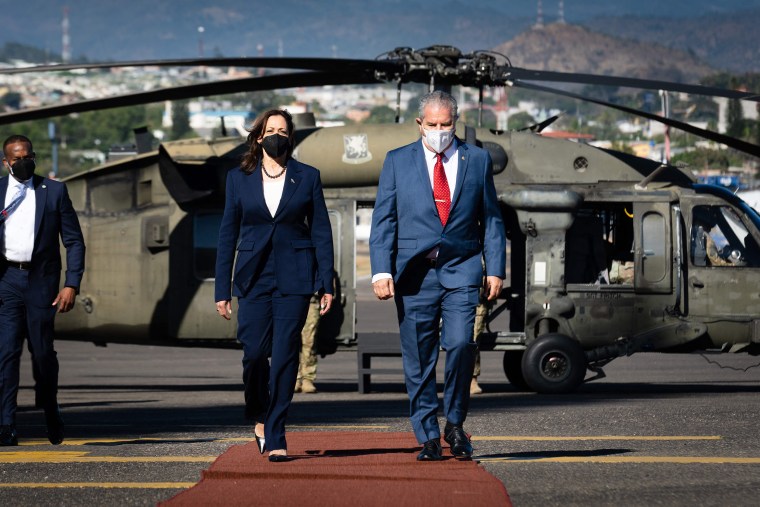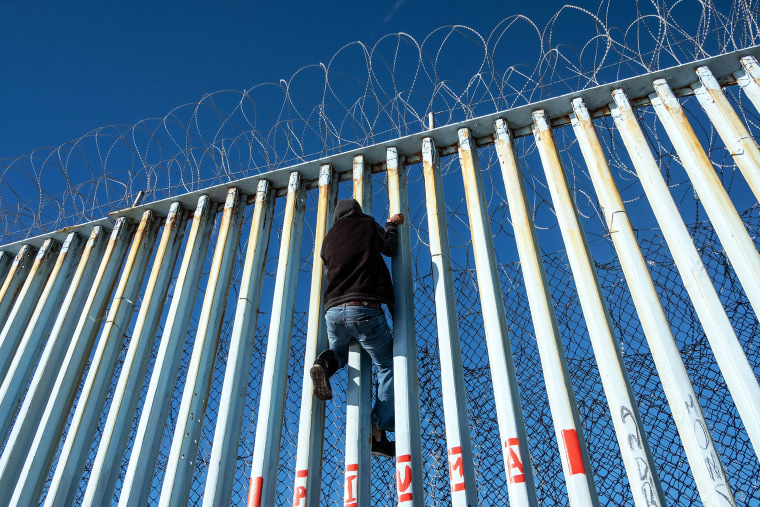
President Joe Biden tapped Kamala Harris to tackle the daunting issue of immigration in March 2021, but the vice president’s public-facing work on addressing the root causes of migration largely evaporated within months, according to an NBC News analysis of public documents, U.S. aid disbursements and Harris’ travel schedule.
Harris traveled to Mexico in June 2021 to sign an agreement that has led to a commitment of $4 billion in direct assistance and over $5.2 billion in private-public investment from the U.S. But she has not visited the southern border, or the countries to its south, since January 2022. And despite requests from Mexico for more investment, her “Root Causes Strategy” made no new financial commitments.
When Harris became Biden’s “border czar,” as critics called her, the administration was under pressure from both sides to address the rising number of migrants — particularly unaccompanied children — crossing the border and landing in poor conditions in U.S. custody. On March 24, 2021, Biden took the stage at the White House and seemed to hand the keys on the issue over to his vice president.
“The vice president has agreed — among the multiple other things that I have her leading, and I appreciate it — agreed to lead our diplomatic effort to work with those nations to accept returnees and enhance migration enforcement at their borders,” Biden said.
In accepting the task, Harris made her role more specific, describing largely diplomatic responsibilities. “I look forward to engaging in diplomacy with government, with the private sector, with civil society and the leaders of each in El Salvador, Guatemala and Honduras to strengthen democracy and the rule of law and ensure shared prosperity in the region. We will collaborate with Mexico and other countries throughout the Western Hemisphere.”
Biden administration officials have pointed to those remarks in rejecting criticism that Harris did not solve the crisis at the border, where there have been record crossings under Biden. They say her job was not to focus on working with countries in the region to address root causes, and they reject the mocking title “border czar.”
The Border Patrol union says Harris did not deliver on any of her immigration-related assignments.
When Harris’ name is mentioned at the border, “it’s a lot of eye rolls,” said Jon Anfinsen, national executive vice president of the National Border Patrol Council, the Border Patrol union.
“I would ask what has she done in terms of solving the root causes. This has been a goal of hers for this many years. What’s changed? I would argue it’s not improved; it has only gotten worse,” Anfinsen said. “Shortly around that period of time, it kind of just went away, and you didn’t hear it.”

But Daniel Suvor, who was chief of policy for Harris from 2014 to 2017 while she was California’s attorney general, said he was unsurprised she was tapped to address root causes of migration in Central America.
“She’s been interested in Central America for some time, and she has built up a wide range of relationships down there,” Suvor said.
Suvor said Harris’ connections in Latin America stemmed from her work as attorney general to combat drug trafficking by transnational criminal organizations and her trips to Mexico City to meet with foreign officials.
“She understood all the way back then that we needed to work with the Mexican government, El Salvador, Honduran, Guatemalan government, to take on the cartels.”
‘Don’t come’
An NBC News review found that her travel to address root issues in the region was largely limited to June 2021, with one trip to the border in El Paso, Texas, and another to Mexico and Guatemala. She made one additional trip to Honduras in January 2022.
Her work in Guatemala may have been most memorable. It was where she faced criticism from immigration groups for telling migrants “don’t come” to the U.S.
But her work in Mexico was arguably the most significant. It was there that Mexico and the U.S. signed a memorandum of understanding to “strengthen development cooperation in northern Central America … to exchange knowledge, experiences, assets, and resources to address the root causes of irregular migration in northern Central America,” according to a description of the agreement by the State Department.
The agreement sent funds from the U.S. Agency for International Development, coupled with those from the Mexican Agency for International Development Cooperation, to help people in Central America. Since then, the U.S. has stayed on track to meet its commitment of $4 billion to address root causes, but Harris has also been able to solicit significant help from private companies, which have invested $5.2 billion in the region since 2021.
Those investments have funded entrepreneurs, ensured labor rights, strengthened food security and launched “19 projects in Guatemala, El Salvador, and Honduras across sectors, including financial inclusion, healthcare, climate finance, and affordable housing,” according to the White House.
Since 2021, however, the Root Causes Strategy has made no new commitments, despite Mexican pleas for more direct investment from the U.S., not just from U.S. companies.
Mexican President Andrés Manuel López Obrador said in May 2022 that the private investment strategy is too slow.
“We are convincing the government of the United States to invest with readiness,” he said at a news conference. “They have a very special system — they think that it’s enough to promote private investments. That if plants, factories are installed in Central America, then employment will be generated. … That is good, but that takes time.”
Harris made one more trip to Central America after 2021, to attend the inauguration of Honduran President Xiomara Castro in January 2022. According to the White House, Harris talked to her about “combating corruption and gender-based violence as a way to address the root causes of migration.”
Since then, she has held two meetings in Washington, one with López Obrador in July 2022 and the other most recently with Guatemalan President Bernardo Arévalo in March.

A White House official defended Harris’ record and said her work is ongoing. “Vice President Harris continues to lead the effort to address the root causes of migration from Honduras, Guatemala, and El Salvador, including by generating more than $5.2 billion in investments into the region to give people economic opportunity at home. These investments are creating jobs and have connected more than 4.5 million people to the internet and brought more than 2.5 million people into the formal financial system.”
“Under the Vice President’s leadership, the Biden-Harris Administration continues to implement the Root Causes Strategy. As a part of this strategy, the Administration is on track to meet its commitment to provide $4 billion to the region over four years and continues to work to combat corruption, reduce violence, and empower women,” the White House official wrote.
Think tanks that study immigration and international non-governmental organizations have also questioned the impact of Harris’ work in addressing immigration.
“She had a very narrow mandate, which was to be the diplomatic representative in Central America at the time when most unauthorized immigration was coming from Central America,” said Andrew Selee, president of the Migration Policy Institute, a nonpartisan think tank based in Washington.
Since 2021, immigration from the Central American countries of Guatemala, El Salvador and Honduras, once the leaders in illegal immigration across the southwest border, has fallen from 86,089 in March 2021 to 25,015 in June 2024, according to Customs and Border Protection data.
But immigration experts point out that the decline is most likely driven by other factors, including U.S. policies restricting asylum at the border and an increase in Mexican interdictions of U.S.-bound migrants. And during that time, migration from countries like Venezuela and China — where Harris has no involvement in immigration discussions — has mounted.
Selee said USAID took over the money the U.S. sent to Central America for development while Harris stayed focused on the private-sector investment.
“Vice President Harris was very involved diplomatically early on with Central American governments, clearing the way to get these two initiatives underway and talking about how to stem unauthorized migration,” Selee said. “But, as near as I can tell, she just hasn’t stayed as engaged diplomatically on this. And, you know, over time, the State Department and the National Security Council really took over the diplomatic side.”
Krish O’Mara Vignarajah, president and CEO of Global Refuge, noted Harris’ role launching an anti-corruption task force with the Justice Department focused on Northern Triangle countries.
“I do think she [Harris] has played a leadership role in addressing the root causes,” Vignarajah said.
“Do we believe this solves the problem? No. Of course not. And this is where Congress needs to be a real player,” she said.